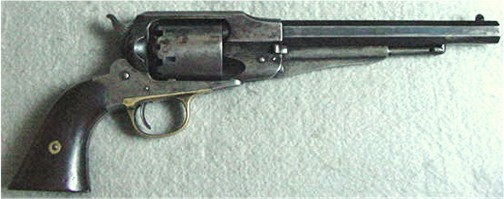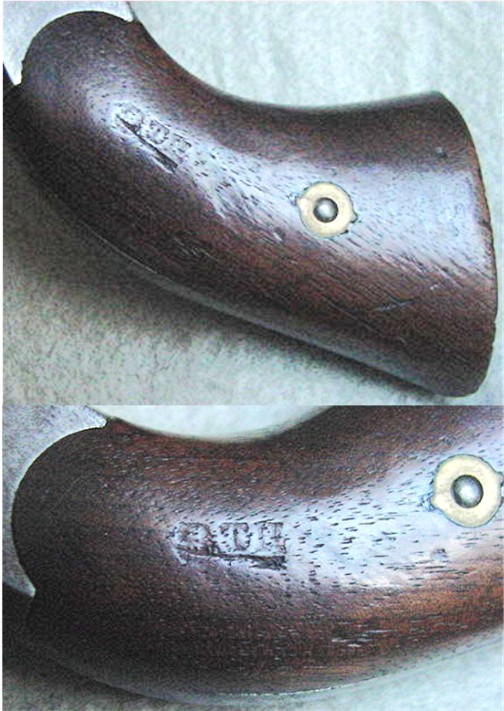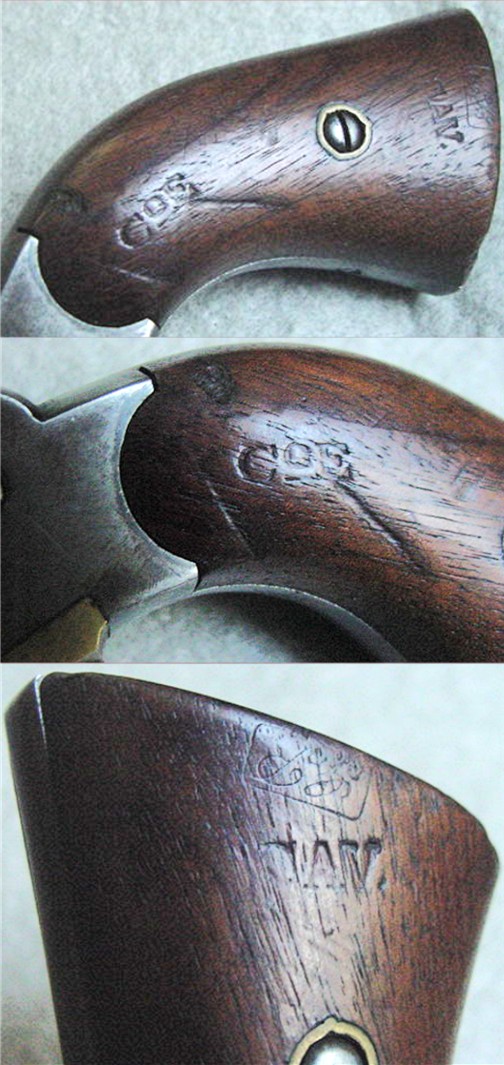|
REMINGTON NEW MODEL ARMY PISTOL – IDENTIFIED TO
COMPANY E 8TH US CAVALRY – A HISTORIC AND
WELL DOCUMENTED EARLY INDIAN WAR ISSUED REVOLVER:
Perhaps the best known
specimen of a Remington New Model Army Revolver
identified as having been in the inventory of the
Company E, 8TH US Cavalry Regiment, this
exact pistol is featured in GUNSMOKE AND SADDLE
LEATHER by Charles Worman.
  
This Remington presents in its original form with none
of the evidence of the refurbishing to which so many of
these early Indian War revolvers were subjected. The
barrel is full length at 8”, and the surfaces were not
repeatedly polished, still retaining crisp edges and
legible inspector stamps. All of the serial numbers
match, save for the cylinder. Whether the cylinder was
swapped with that from another gun inadvertently while
being cleaned or serviced, or the cylinder was replaced
due to being damaged, this cylinder has been with this
revolver since its period of use on the frontier and it
matches the balance of the gun in every way. Most
importantly, the grip panel bears the same matching last
three digits of the pistol’s serial number, confirming
these unit identified grips belong to this pistol.
Both of the pistol’s grip panels bear the legible stamps
- “Co E” and “CAV” on the left panel and “8TH”
on the right panel - establishing the issue of this
pistol to Company E of the 8TH US Cavalry
Regiment The format and font of this stamping is
identical as those noted on the grips of two Model 1860
Colt Army revolvers, and on three Model 1868 Sharps
Carbines – all bearing the same “Co E 8TH
CAV” stamping, using the same font and format.
The 8TH US Cavalry Regiment was created after
the Civil War in 1866, at the Presidio of Monterey,
California as the army reorganized and expanded to meet
the demands of the advancing frontier. Since the Model
1860 Colt Army pistols were replaced in 1874 with the
adoption of the Model 1873 Colt Single Actions, the
markings on the grips of this pistol were applied during
that fairly tight intervening period of eight years.
During that early Indian Wars period, the 8TH
was attached to the Department of California, and
Company E was stationed, and saw considerable action, in
Oregon against the Modocs, in Idaho against the Nez
Perce and Bannocks, and in the Arizona Territory against
the Apaches.
It is worth noting that while the army did not approve
of such unit identification stamps on the firearms, and
in fact, specifically prohibited the practice via
written orders, there were several units on the frontier
that regularly applied stamped identification marks on
their guns, to include the 3RD, 4TH,
8TH, 9TH, and 10TH
Cavalry Regiments. Of special interest is that as the
army discouraged the practice, and therefore never
established a service-wide standard for content, font,
or placement of the identification stamps on the arms,
each unit developed their own unique criteria and style,
and more often than not, located the stamps on the same
place on the firearms within a company or regiment. The
unique nature of these stamps has proven to be a boon to
modern collectors, as once familiar with the placement
and style of a particular unit’s stampings, the
collector is better equipped to identify genuine stamps
from spurious stamps that may be applied to enhance an
unmarked piece, and as many of these early frontier arms
were used heavily and often show significant wear, in
the cases where a portion of the markings have been
partially worn or obliterated, what markings remain are
sufficient to make a complete identification of the unit
possible.
There is no doubt whatsoever that the stampings are
original to the pistol’s period of use, and that they
are indeed genuine 8TH Cavalry markings. The
grips, numbered to this pistol and obviously original to
the revolver, are in very good condition with little of
the significant wear commonly encountered on the
revolvers which were used in the field.
As a result, the fully legible stamping on these grips
easily rates as excellent. As noted above, both grip
panels on this Remington were utilized to stamp the “Co
E 8TH CAV” identification. While the entire
Co. E 8TH CAV stamp has been found stamped on
both sides of the one piece grip of Colt Army Pistols, I
suspect that the one set of stampings was divided
between the two grip panels of the Remington
specifically because the screw holes used to mount the
separate grip panels limited the amount of space
available, and the thinner grip scales were more
inclined to split if the stamps were applied too close
to the screw holes.
Showing little, if any, wear across the length of each
stamping, all of the characters are fully present and
only the sharp edges which would have stood proud of the
surface when the grips were newly stamped have worn away
with time and use. The original inspector’s cartouche
is still fully legible on the left side, immediately
below the “CAV” portion of the stamping, between the
stamping and the bottom edge of the grip.
The mechanics are excellent, with the cylinder indexing
properly and locking up tight at full cock. The metal
finish is very smooth with quite a bit of the original
blue finish remaining in protected places – quite vivid
in places such as the bottom flat of the barrel and the
top flat of the loading lever. The proper inspector’s
marks are still visible in all the correct places, and
the barrel address stamping is clear and legible.
Most of these post-Civil War Remington Pistols which
were issued to the frontier army were exposed to harsh
and extensive service, and many of them probably did not
survive to be available today. Not only did this
important specimen survive in very nice condition, but
it is also unit marked in a well recognized manner which
adds considerably to the value. Well documented, these
unit marked pistols have become very desirable and are
quite difficult to find. There will be no doubt that
you are holding a true piece of history from the early
Indian Wars and one that was carried on the American
Frontier.
SOLD
|

